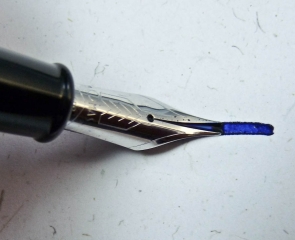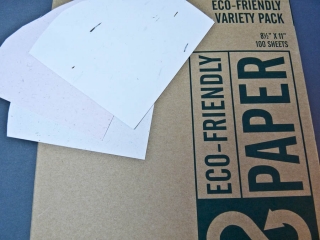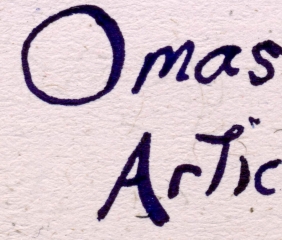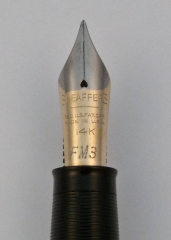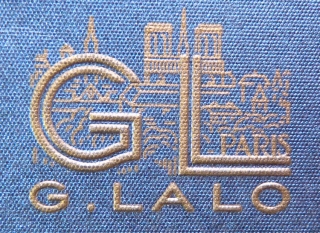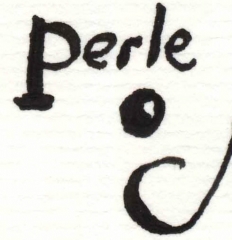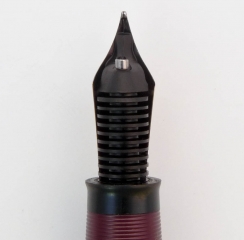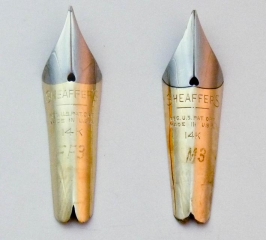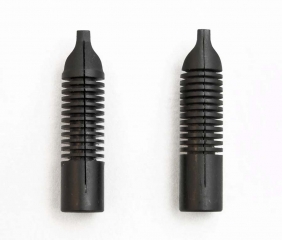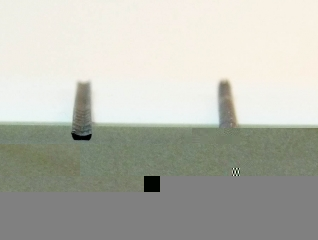Everyone loves cheap and cheerful. Who doesn’t want to get something fun for very little money? OK, so maybe the filthy rich don’t care but for me when I see something new, cool, and affordable I’m all over it. Of course the results are a lot of junk I’ve used one time or less sitting about but that’s the way it goes for those of us with impulse buying syndrome (IBS). Sure, that tiny battery operated egg whipper looked so cool in the package but when you realize what it gives eggs is more like a lashing you find a spot in the junk drawer for it. There it lives until the bi or tri-annual household junk cleansing where, if lucky, your embarrassment goes into the charity box with the unit.
Since I collect fountain pens I was thrilled to see an announcement form JetPens that they would be selling some writing instruments that fall into this category. Now let me state here that I still think the best value in fountain pens remains restored or NOS vintage models. Often the less sought after can be had for only a few dollars (Sheaffer’s NoNonsense line for example) or tens of dollars (Sheaffer’s mid-market pens from the 60s) and they are usually made to higher standards than you’ll find in cheap pens today. When I saw that the new Noodler’s fountain pens were ready to ship I couldn’t help myself and picked up a few. I also received a few extra purchased by friends in faraway places so after delivery I am swimming in Noodler’s pens which makes it good time to review them.

History
If you don’t know what Noodler’s is I’ll give you a quick summary here: Nathan Tardiff was well known a dozen years or so ago when I got into fountain pens in a big way. Considered a knowledgeable collector and ace repair person I even bought a pen or two from him. In recent years he started a line of well-respected and innovative (and sometimes controversial) inks. Noodler’s inks give you a huge color range and a good value which I don’t think anyone can dispute. Expanding his range he is now offering two models of fountain pens.
The first and lower priced line is a piston filler in a range of plastic colors with a screw cap. It’s a basic design that reminds me of German school pens of the 60s and 70s. The other is an aerometric filler in hard rubber with a slip cap. These pens come in your choice of green mottled and brown mottled. The design has tapered ends somewhat like a vintage Sheaffer Balance. This pen also has a gasket on the section so it can be converted into an eyedropper filler if you wish.
Construction
Both pens are made well enough for their price point. The plastic one has a very simple piston design which is workable and it feels solid in hand. The most noticeable exterior feature are ink view windows which are sized right to be handy. Both models have the same style nibs which are called fine-medium like they have an identity crisis. The price point is “cheap” so don’t expect jewel like details. The trim and fittings are sturdy but nothing more. The plastic on the piston filler shows changes in color where the dye must have changed concentration. The tip which retains the clip on the hard rubber model is very small in diameter giving it a “dunce cap” look. I’m happy to see a silicon sac is used in the aerometric filling system which is nice since you can see the ink level.

Where the ink meets the paper you have a steel nib that is functional and smooth enough. The feed is a hard rubber comb variety which is basically the same thing you’d see on a pen from the 1930s and so is reliable and simple.
As I said you get your money’s worth but don’t expect any surprise and delight. While not a piston filler the Pilot 78g is noticeably higher quality if you want a peer comparison. Noodler’s Hard rubber pen, however, seems to have no competitor at its price. Still for about 1/3 more you can get one of Steve Braun’s Varuna fountain pens that are eye-droppers only but heftier, more solid and expensive feeling.
Use
Using either Noodler’s model is simplicity in itself. Turn the knob and the piston filler fills. On the aerometric pen you compress the sac a few times. Both work flawlessly. There is a bit of effort in converting the hard rubber aero pen to eyedropper but it’s not rocket science. You remove the sac cage and the sac and that is It since the previously mentioned seal is already there to make it water tight.
Cost
I’ve been asked a few times what I think of these pens since I got them the other day because the attractive price is a draw. My major remark is they are honest and a bit unusual pens for this price point and certainly will be entertaining.
Modification
One claim to fame for these pens is that the nib and feed can be pulled out since they are friction fit. Why do that you ask? Well, if you have a #2 vintage nib lying about you could stick that into your pen and voila! A whole new writing experience! Technically a stub, italic, or even flex nib could be fitted if you wish a change. In reality there are some problems since not every #2 nib is the same nor even usable in these pens. The major issue is that the steel nibs from the factory are rather thick in cross-section and vintage nibs seem for the most part thinner. This is especially true of nibs that have some flex. What you wind up with often is a lose nib pushed way back into the section to get some purchase. This isn’t acceptable for me. I did find a few nibs that fit better but were more a #3 size so that’s something to keep in mind.

Quality
So far I’ve seen a few complaints about these pens from new owners. Most seem to be lapses in QC like crooked nibs or sections getting stuck when being screwed. The thin and weak product boxes don’t help since they offer little protection so when shipped caps can fall off and pens can work lose. Crushing is certainly a possibility as well. Time will tell if some of these problems are just teething pains.
Summary (and a meme reference that will be out of date in 5 minutes)
A friend joked that I should have a rating system for pens and we came up with the “double rainbow” system. It goes in half-rainbow increments from 0 (the lowest grade, equivalent to writing with a rusty nail dipped in beet juice) to 2 (the highest rating which is like a sweet flex nib Sheaffer). These pens would be a 1 rainbow from me because while unremarkable do give you value for what little you spend. Still I won’t recommend these and will suggest a Pilot or slightly more expensive modern pen, such as a Lamy, to those seeking entry level fountain pens due to some spotty QC issues. If you must have a piston or hard rubber pen I’d say look for inexpensive NOS or restored pens of this type. My Lamy 27 (piston filler) is far, far superior in construction and feel than the Noodler’s and with some looking not that more expensive.














